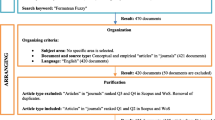Abstract
Natural-language information is often mathematically expressed by fuzzy sets. With the random set theory as a bridge, this kind of information can be transformed into fuzzy evidence in Dempster-Shafer (DS) theory. Then Dempster’s combination rule or other combination rules of evidence can be used perfectly for fusing natural-language and other information. However, this traditional transformation involves the use of α-cut sets to construct the focal elements which have to be represented as consonant sets. This construction is very inflexible and unreasonable in some practical applications. In this paper, with the desire to overcome this limitation, a method for constructing more general non-consonant focal elements is proposed based on the random set theory. Some examples are given to show the generality and the efficiency of this new method. Finally, we validate that non-consonant constructions provide less degrees of total uncertainty than that of the consonant case in these examples by using the evaluation criterion of total uncertainty
Similar content being viewed by others
References
G. Shafer. A Mathematical Theory of Evidence. NJ, Princeton University Press, 1976, 57–73.
M. Florea, A. L. Jousselme, D. Grenier, et al. Combining belief functions and fuzzy membership functions. Proceedings of SPIE, 5099(2003), 113–122.
N. R. Pal, J. C. Bezdek, and R. Hemasinha. Uncertainty measures for evidential reasoning II: a new measure of total uncertainty. International Journal of Approximate Reasoning, 8(1993), 1–16.
I. R. Goodman, R. P. S. Mahler, and H. T. Nguyen. Mathematics of Data Fusion. Kluwen Academic Publishers, 1997, 45–48.
I. R. Goodman and H. T. Nguyen. Uncertainty Models for Knowledge-based Systems. New York, Elsevier Science Inc., 1985, 33–49.
L. A. Zadeh. Fuzzy sets. Information and Control, 8(1965), 338–353.
Wen Chenglin and Xu Xiaobin. Modeling multisource heterogenous information based on random set and fuzzy set theory. Journal of Donghua University, 23(2006)6, 87–93.
Author information
Authors and Affiliations
Corresponding author
Additional information
Supported by the National Natural Science Foundation of China (60772006) and the Zhejiang Natural Science Foundation (R106745, Y1080422).
Communication author: Xu Xiaobin, born in 1980, male, Ph.D.
About this article
Cite this article
Xu, X., Wen, C. & Li, Z. A new method for constructing fuzzy evidence based on the non-consonant random set. J. Electron.(China) 26, 31–37 (2009). https://doi.org/10.1007/s11767-008-0118-4
Received:
Revised:
Published:
Issue Date:
DOI: https://doi.org/10.1007/s11767-008-0118-4




